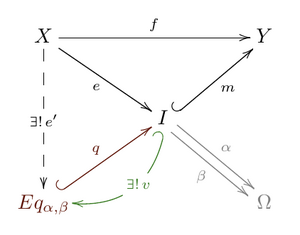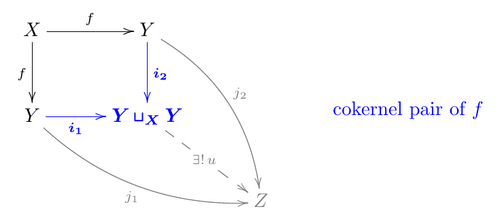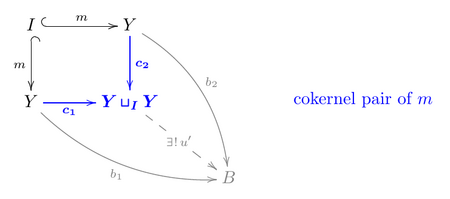Image (category theory)
 From HandWiki - Reading time: 6 min
From HandWiki - Reading time: 6 min
In category theory, a branch of mathematics, the image of a morphism is a generalization of the image of a function.
General definition
Given a category
- There exists a morphism
- For any object
Remarks:
- such a factorization does not necessarily exist.
The image of
Proposition: If
Let
This means that
Second definition
In a category
Remarks:
- Finite bicompleteness of the category ensures that pushouts and equalizers exist.
- In an abelian category, the cokernel pair property can be written
Theorem — If
First definition implies the second: Assume that (1) holds with
- Equalization: one needs to show that
- Universality: in a category with all colimits (or at least all pushouts)
- Moreover, as a regular monomorphism,
- Indeed, by construction
- Finally, use the cokernel pair diagram (of
Second definition implies the first:
- Factorization: taking
- Universality: let
- Then
- Now, from
Examples
In the category of sets the image of a morphism
In any normal category with a zero object and kernels and cokernels for every morphism, the image of a morphism
- im f = ker coker f
In an abelian category (which is in particular binormal), if f is a monomorphism then f = ker coker f, and so f = im f.
See also
References
- ↑ Mitchell, Barry (1965), Theory of categories, Pure and applied mathematics, 17, Academic Press, ISBN 978-0-12-499250-4 Section I.10 p.12
- ↑ Mitchell, Barry (1965), Theory of categories, Pure and applied mathematics, 17, Academic Press, ISBN 978-0-12-499250-4 Proposition 10.1 p.12
- ↑ Kashiwara, Masaki; Schapira, Pierre (2006), "Categories and Sheaves", Grundlehren der Mathematischen Wissenschaften, 332, Berlin Heidelberg: Springer, pp. 113–114 Definition 5.1.1
 |
30 views | Status: cached on July 29 2024 06:03:02
↧ Download this article as ZWI file
 KSF
KSF





